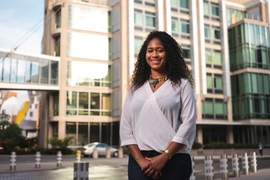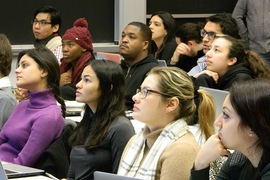Dozens of undergraduate students gather each year at the annual MIT Summer Research Program (MSRP) poster session to present the work they have completed over the course of the summer at MIT.
This year the poster session featured research from 37 undergraduates from MSRP General, 37 undergraduates from the MSRP Bio and Neuroscience cohort, and six students from the Emergent Behaviors of Integrated Cellular Systems (EBICS) program. These students came from institutions around the country to pursue research and explore departments across MIT.
Marking the conclusion of an immersive research experience, the poster session showed these 80 diverse students that they have at least one thing in common: They can make an impact in their respective research areas by proposing solutions to problems that have never been solved before.
Administered by the Office of Graduate Education, MSRP strives to expose high-achieving sophomores, juniors, and seniors to the academic world, to improve the research environment by increasing the number of underrepresented minorities and underserved students in scientific research, and to encourage students to apply for a graduate program at MIT.
MSRP began in 1986 with a handful of students and has blossomed into a phenomenal community of young researchers prepared to pursue advanced degrees. Students in MSRP are given the opportunity to see MIT in its fullest form by living on campus and working alongside graduate students, postdoctoral researchers, research scientists, and professors.
“From this experience, I now believe that I am revolutionary,” says Talia Thomas, from North Carolina Agricultural and Technical State University. “I’m going to make it my mission to make sure that other people realize that they are revolutionary as well, and that they can realize their full potential.”
This year’s program spanned 10 weeks of intense research and personal development, with students diving into exciting work in electrical engineering and computer science, architecture, urban planning, and more. In addition to research, students attended weekly workshops featuring different aspects of the graduate journey, such as a “Life after the PhD” seminar with MSRP alumni and a “How to write the Statement of Objectives” workshop with Donald Asher, an expert in graduate admissions.
Other weekly events included a scientific communication class every Wednesday, group meetings led by MIT graduate students, and seminars featuring faculty, such as associate professor of mechanical engineering Cullen Buie. To build trust and foster friendships, almost every weekend included social outings, including a boat cruise on the Charles River, a day trip to Martha’s Vineyard, and a visit to a local amusement park.
As the students return home, they carry with them both new skills learned in their labs and inspiration that comes from finding people as driven to change the world as they are. Jumping into research headfirst is no easy task, but leaving with a better understanding of their fields and how to conduct research to better the world is well worth the challenge.
The student researchers now join the network of MSRP alumni, a community confident in its ability to bring diverse talent to research environments and make a positive impact in the world.









